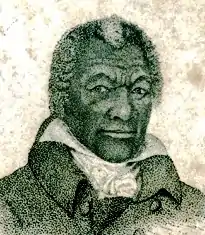James Armistead Lafayette
James Armistead Lafayette (born 1748[1] or 1760[2] – died 1830[1] or 1832)[2] was an enslaved African American who served the Continental Army during the American Revolutionary War under the Marquis de Lafayette.[3] As a double agent, he was responsible for reporting the activities of Benedict Arnold – after he had defected to the British – and of Lord Cornwallis during the run-up to the Battle of Yorktown. He fed the British false information while disclosing very accurate and detailed accounts to the Americans.
James Armistead Lafayette | |
|---|---|
 | |
| Born | James Armistead 1748 or 1760 |
| Died | 1830 or 1832 (aged 69–72 or 81–84) |
| Nationality | American |
| Espionage activity | |
| Allegiance | American |
Early life
Armistead, an enslaved man, was owned by William Armistead of Virginia. Most sources indicate that James Armistead was born in 1748 in New Kent County, Virginia,[1] though others put his birth around 1760.[2]
Role in the American Revolution
In 1781, after getting his enslaver’s consent, Armistead volunteered to join the army under Lafayette. Lafayette utilized Armistead as a spy, with the latter posing as a runaway slave. Armistead joined the camp of Brigadier General Benedict Arnold, the turncoat who was leading some British forces in the area. Pretending to be a spy for them allowed Armistead to gain Arnold's confidence to the extent that Arnold used him to guide British troops through local roads. "The ex-slave, who later renamed himself James Armistead Lafayette in the general's honor, served as a double agent against the British under the avowedly anti-slavery Lafayette."[4]
After Arnold departed north in the spring of 1781, James went to the camp of Lord Charles Cornwallis and continued his work. He moved frequently between British camps where the officers would speak openly about their strategies in front of him. Armistead documented this information in written reports, which he delivered to other American spies. In this way, he relayed much information about the British plans for troop deployment and their arms. The intelligence reports from his espionage were instrumental in helping the revolutionary forces defeat the British during the Battle of Yorktown.[2][5]
Lafayette's return
In 1824, the Marquis de Lafayette returned to the United States at the invitation of President James Monroe. He made a tour of all 24 states, during which he was met by huge crowds and everywhere feted as a hero. He visited Washington's grave at Mount Vernon and gave a speech to the House of Delegates in Richmond. While in Richmond, he abruptly had his carriage stopped when he saw Armistead in the crowd and rushed to embrace him.[6]

Emancipation
Although Virginia passed a manumission act in 1782 allowing for the freedom of any slave who had fought in the Revolution, James Armistead remained the property of William Armistead.[7] This was because a 1783 law specifically freed only slaves whose owners had used them as substitutes for army service in exchange for their liberty. This was not the case for Armistead, who had been a spy, not a soldier. However, in 1786, with the support of William Armistead – then a member of the House of Delegates – and a 1784 testimonial as to James Armistead's service under Lafayette, made by the Marquis himself,[8] James petitioned the Virginia Assembly for his freedom. On January 9, 1787, the Assembly granted the petition. At that time, he added "Lafayette" to his name to honor the general.[5]
James Armistead Lafayette continued to live in New Kent County with his new wife, one son and several other children and became a wealthy farmer.[9][10] In 1818, he applied to the state legislature for financial aid; he was granted $60 for present relief and a $40 annual pension for his services in the Revolutionary War.
See also
References
Notes
- Salmon, John. "Lafayette, James (ca. 1748–1830)". Encyclopedia Virginia. Retrieved 2016-05-04.
- Quinn, Ruth (January 31, 2014). "James Armistead Lafayette, (1760–1832)". United States Army. Retrieved July 18, 2018.
- Du Bois, William Edward Burghardt (1976). The Crisis. 83–84. Crisis Publishing Company. p. 364.
- White, Deborah Gray (2013). Freedom on my Mind: a History of African Americans (Volume 1 ed.). Boston: Bedford/ St. Martin's. pp. 154–155. ISBN 978-0-312-64883-1.
- "James Armistead Lafayette". Lafayette College. Retrieved June 26, 2013.
- Jacoby, Oren (Director) (2010). Lafayette: The Lost Hero (Television).
- Virginia; Hening, William Waller (1823). "Chapter LXXXIX, An act to emancipate James, a negro slave, the property of William Armistead, gentleman". The statutes at large: being a collection of all the laws of Virginia, from the first session of the legislature, in the year 1619. Published pursuant to an act of the General assembly of Virginia, passed on the fifth day of February one thousand eight hundred and eight, Volume 12. p. 380. Retrieved 2019-07-08.
- "Lafayette's Testimonial to James Armistead Lafayette". Lafayette College.
- "James Armistead". biography.com.
- "Manumission Petition for James Lafayette". Virginiamemory.com. Retrieved 2019-07-08.
Further reading
- Abdul-Jabbar, Kareem; Steinberg, Alan (1996). Black Profiles in Courage: A Legacy of African-American Achievement. New York: William Morrow. ISBN 978-0688130978.
- Kapan, Sidney; Kaplan, Emma Nogrady (1989). The Black Presence in the Era of the American Revolution. Amherst: University of Massachusetts Press. ISBN 9781122052689.
- Rockwell, Anne (2016). A Spy Called James: The True Story of James Lafayette, Revolutionary War Double Agent. Minneapolis: Carlhoda. ISBN 978-1467749336.
- Ward, Harry M. (2011). For Virginia and for Independence: Twenty-Eight Revolutionary War Soldiers from the Old Dominion. Jefferson: McFarland. ISBN 978-0786461301.
- Woelfle, Gretchen (2016). Answering the Cry for Freedom: Stories of African Americans and the American Revolutionary. Westminster: Calkins Creek. ISBN 978-1629793061.
External links
 Media related to James Armistead Lafayette at Wikimedia Commons
Media related to James Armistead Lafayette at Wikimedia Commons